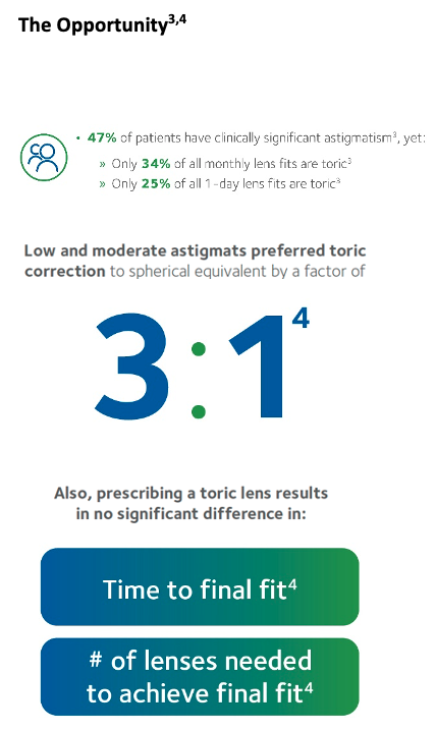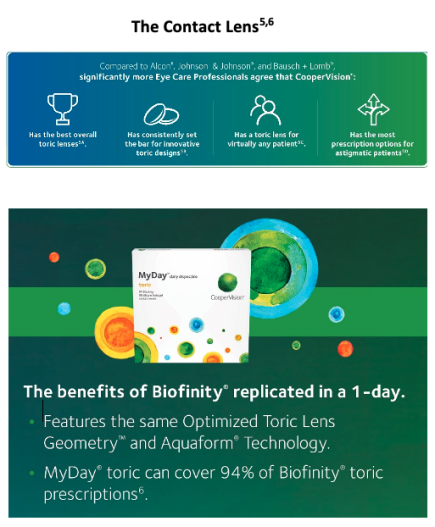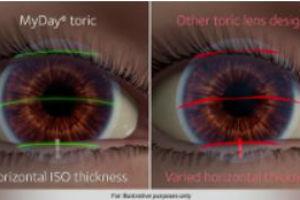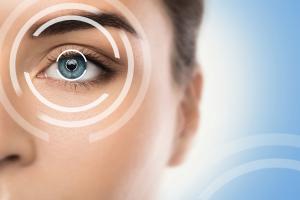While Leonardo DaVinci is sometimes credited as the original creator of the contact lens concept[1], the history of correcting astigmatism started much later. It was 1801 (almost 300 years after DaVinci’s original experiments in optics) that Dr. Thomas Young identified the cause of astigmatism and used water filled tubes to correct for it.[2] The next key advancement in toric technology came in 1827 when Dr. George Airy described an optical theory of astigmatism and even a theoretical back surface toric lens. It would take another 150 years for the development of the first commercial soft toric contact lens to correct astigmatism. In a significant breakthrough for astigmats, in 1978 Hydron received FDA approval for a 38%-water HEMA, lathe-cut, truncated, prism-ballasted toric lens called the “Rx toric”. This was followed soon after by an improved design called the Hydron Z6 toric contact lens.
Over the last 40 years the pace of innovation in soft contact lenses, in general, and soft toric contact lenses has accelerated significantly. At the present time there are several silicone hydrogel 1-day toric contact lenses including the clariti 1 day toric and MyDay toric contact lenses from CooperVision. To get a perspective on the changes in toric design and performance over time we spoke with Dr. Carmen Castellano, who is in private practice at Koetting Eye Center, an optometric group practice specializing in contact lenses.

Dr. Castellano has been involved in clinical research and fitting of toric contact lenses for the past 40 years. Among his many professional accolades, Dr. Castellano is a Diplomate in the American Academy of Optometry Section on Cornea, Contact Lenses and Refractive Technologies, a Distinguished Practitioner in the National Academies of Practice in Optometry and served as the Benedict Professor of Practice Management at the University of Houston College of Optometry. In 2019, Dr. Castellano received the Luminary Award from the American Optometric Association Contact Lens and Cornea Section.
Dr. Castellano, you've published several articles about toric contact lenses and their performance going back to 1989. When you think about those early toric lenses that you were fitting, what was your impression about things that are important to ECPs, the ease of fit, the consistency of performance and overall lens performance for the patient?
Dr. Castellano:
Well, it probably would be best to start even before 1989, because there's a difference in those first few years versus what I experienced as we got closer to the '90s. When I first came out of school and went into practice in 1982, all lenses were some form of conventional, and of course now, they're all some form of disposable.

Those early toric designs offered a lot of promise, because now, for once, we had an opportunity with soft contact lenses to handle our astigmatic patients. The problem was, they weren't very reproducible. In fact, a common joke at the time was that toric soft contact lenses are like snowflakes because no two are alike.
You'd put on a lens, and what was designed to be a duplicate replacement lens didn't always work the way its predecessor did. It was difficult, but nonetheless, it was a breakthrough.
What do you think are the most significant improvements that have happened in toric lenses over the last 40 years?
Dr. Castellano:
First, the designs got better and better, and certainly more consistent. Then eventually, with disposability, amazingly, we were able to have these very reproducible, reliable, stable lenses to work with. From there, it has just taken off to the point where, in the early days, we used a toric lens when we had to, now we use a toric lens when we need to.
A significant advancement in contact lens materials in general, has been the creation of silicone hydrogel disposable contact lenses. Our first SiHy toric lens was the Biofinity® Toric contact lens which launched in 2008. What has been your experience with the Biofinity® Toric?
Dr. Castellano:
We have been proponents of the Biofinity Toric for a long, long time, because, in spite of the fact that we were now seeing more and more options with toric lenses and pretty much all of them an improvement over where we had been, the Biofinity® toric was a breakthrough because of the stability of the lens, the ease of fit and the comfort of the lens. With it being a silicone hydrogel material, it really fit well into our practice and still does today. It's probably our most prescribed toric lens. That's the other really nice thing about the Biofinity is with XR, my goodness, - you can fit just about anybody.
I’d like to get your thoughts on toric fitting behaviors of ECPs. Even though more than 40% of spectacle wearers require some sort of astigmatic correction, only 27% of soft contact lens fits are in a toric lens. From the practitioner side, why do you think there's this disparity between patients that have astigmatism,
clinically relevant astigmatism, and the proportion that are fit and soft contact lenses?
Dr. Castellano:
I think it has to do with perception on the part of the practitioner on the difficulty, or relative difficulty, of fitting these lenses versus a spherical lens, and unfortunately these days, that's not even true.
What benefits have you seen, both from the perspective of the patient and for the practice of not trying to mask astigmatism, but really correcting it?
Dr. Castellano:
Well certainly for the patient, it is beneficial because they're getting a higher quality of vision that they recognize, much closer to what they would expect to be seeing when they wear their spectacles.
From a practitioner standpoint, it's a great practice growth opportunity, because when people who many times had been told they either can't wear contact lenses, or this is the best vision we can give you with a contact lens. Then you put a pair of these on and right off the bat, they have better vision quality at insertion, it's a great practice builder.
What would you say to your colleagues that are still fitting low astigmats with spherical equivalent lenses versus fully correcting astigmatism?
Dr. Castellano:
I would just say that, even with a low degree of uncorrected astigmatism, oftentimes patients are not going to feel they're seeing as well as they could or need to, especially with what we do these days on spending so much time in concentrated, viewing on devices and screens. To give them the optimum visual acuity is really beneficial for their vision and they're so darn simple to fit. Why not try it?
You mentioned that Biofinity® toric is your go-to toric for a reusable contact lens, what has been your experience with MyDay® toric?

Dr. Castellano:
That was an easy sell for me to try a MyDay Toric, because MyDay, to me, is a very, very comfortable lens, and I have had a good experience with fitting it. When MyDay toric came along, it was all of the same ocular advantages of Biofinity except that now you've got a daily option. I feel like it has a lot of the same characteristics, stability, comfort, ease of fit, and a good parameter range.
You've been fitting toric lenses for over 30 years. If you look into your crystal ball, what do you think the toric contact lens market will look like 15 years from now?
Dr. Castellano:
I think that we'll continue to see more and more people in toric lenses. I think what you may end up seeing is increasing options for presbyopic astigmats and maybe even additional options for lower than three quarters of cylinder to enable continued refinement. Obviously, with a pair of spectacles, you can prescribe any power you want to prescribe. Maybe at some point, that's where we're going to be with toric soft lenses as well. And continued advancements in materials from the standpoint of physiology and better comfort. I think that's going to happen with torics and all lenses.
It's been quite a journey over the past 40+ years of soft toric contact lens innovations to get us where we are today – a bright future with a significant untapped opportunity to fit more astigmats in a 1 day toric contact lens like MyDay® toric.
[1] Heitz, RF and Enoch, J. M. (1987) "Leonardo da Vinci: An assessment on his discourses on image formation in the eye." Advances in Diagnostic Visual Optics 19—26, Springer-Verlag
[2] Young, T., 1801. On the mechanism of the eye. Philos. Trans. R. Soc. 16, 23–88.
[3] Young G, Sulley A, Hunt C. Prevalence of astigmatism in relation to soft contact lens fitting. Eye Contact Lens. 2011; 37(1): 20-25.
[4] Cox S, Berntsen D, Bickle K et al. Efficacy of Toric Contact Lenses in Fitting and Patient-Reported Outcomes in Contact Lens Wearers. Eye & Contact Lens: Science & Clinical Practice. 2018;44:S296-S299. doi:10.1097/icl.0000000000000418.
[5] A) CooperVision data on file 2020. Kubic masked online survey; n=404 US ODs who prescribe toric soft CLs. 46% CVI, 11% Alcon, 14% B+L, 25% JJV; p<0.05. B) CooperVision data on file 2020. Kubic masked online survey; n=404 US ODs who prescribe toric soft CLs. 41% CVI, 10% Alcon, 17% B+L, 22% JJV; p<0.05. C) CVI data on file 2020. Kubic masked online survey; n=404 US ODs who prescribe toric soft CLs. 77% CVI, 31% Alcon, 40% B+L, 41% JJV; p<0.05). D) CooperVision data on file 2020. Kubic masked online survey; n=404 US ODs who prescribe toric soft CLs. CVI 65% vs 4% Alcon, 14% B+L and 14% JJV; p<0.05.
[6] CVI data on file 2017.







